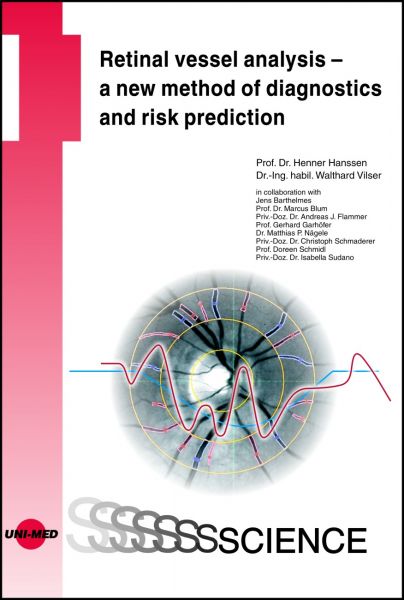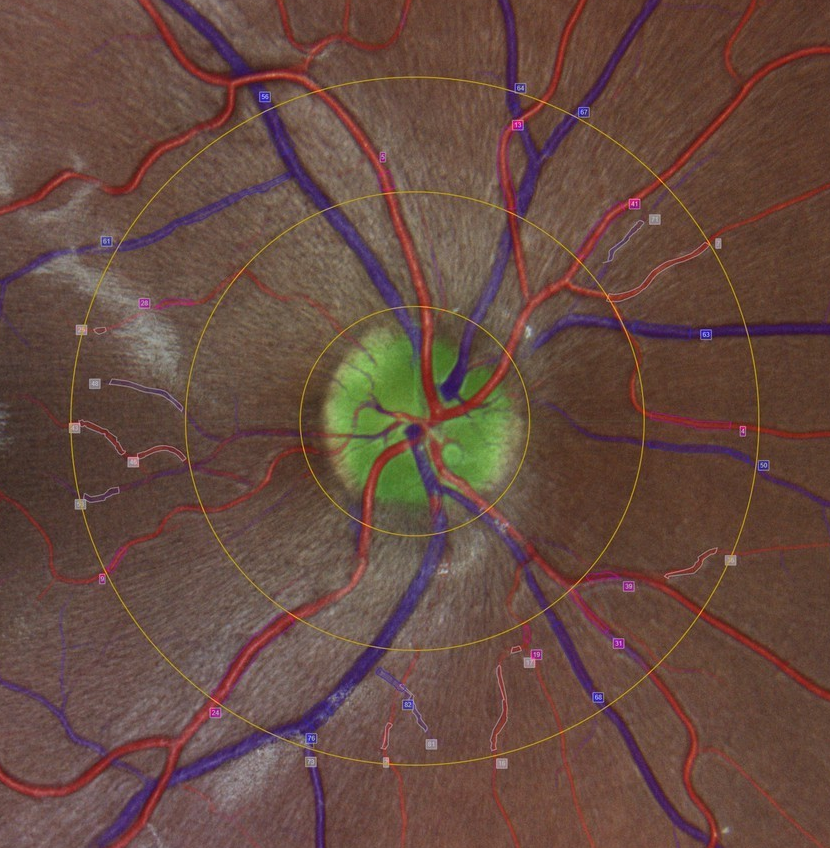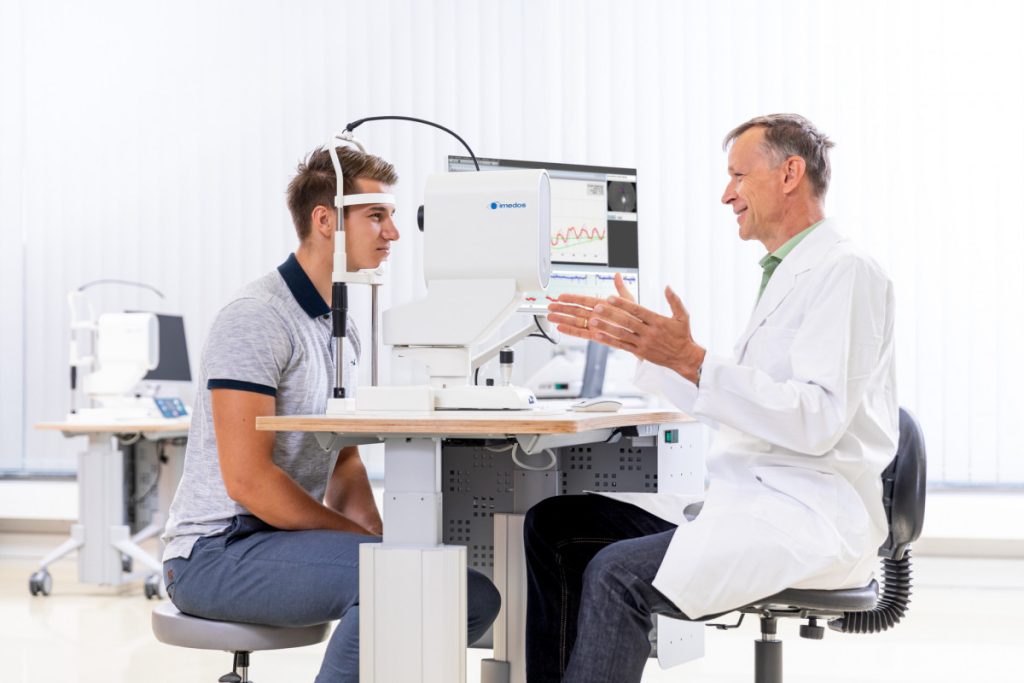Methods of Retinal Vessel Analysis
Retinal vascular analysis, which can be performed both statically and dynamically, offers unprecedented possibilities for non-invasive examination of the vital and health-relevant microcirculation. It provides important information about the systemic vascular health of patients. As a “mirror image” of microvascular changes in the entire body, vascular analysis enables important conclusions to be drawn about systemic diseases and the development of end organ damage.
Static vascular analysis - method for non-invasive assessment of vascular condition.
Static vessel analysis is an excellent and effective method for non-invasive and non-contact examination of the condition and morphology of the microcirculatory vessels. During this examination, arterioles and venules of the retina are imaged with a fundus camera to determine clinically relevant parameters of the vascular topology. Our extremely precise and easy-to-use AI-supported analysis software VesselMap, developed for this purpose analysis software VesselMap is ideally suited for use in research. The vascular parameters recorded represent valid biomarkers that have already been confirmed by large studies and can be used as risk factors or prognosis indicators for vascular diseases and vascular events.
Dynamic vascular analysis - method for non-invasive investigation of the function and autoregulation of microvessels
The worldwide unique method of dynamic vessel analysis enables a non-invasive examination of the functional and autoregulatory mechanisms of the smallest vessels. As an exceptional approach to microcirculation and endothelial function, vascular analysis on the eye provides essential information on subclinical changes in the entire body. This provides information about general vascular health and allows important conclusions to be drawn about systemic diseases and the development of end organ damage.
To analyze and quantify these functional autoregulatory mechanisms, our proprietary software measures and evaluates the time-varying vascular topology in video sequences in real time. During these measurements, the vascular autoregulatory mechanisms are stimulated, whereby the resulting dynamic vascular response is integrally included in the analyses.
The Imedos Dynamic Analyzer uses flicker light as a standard functional diagnostic stimulation to study retinal endothelium-dependent microvascular dysfunction. The vascular response is NO-mediated (endothelial NO synthase) and plays a key role among the regulatory mechanisms of vascular autoregulation and in many microcirculatory disorders and vascular diseases of various organs. Dynamic vascular analysis is therefore ideally suited for interdisciplinary use in clinical routine as well as for medical research.
Download:
Product Brochure Dynamic Vascular Analysis (German)
Product Brochure Dynamic Vascular Analysis (English)
Further information online:
Retinal vascular analysis: Mirror image of the microvasculature
(Article by R. Gerste in the German Medical Journal)
Endothelial function in cardiovascular medicine
A consensus paper of the European Society of Cardiology Working Groups on Atherosclerosis and Vascular Biology, Aorta and Peripheral Vascular Diseases, Coronary Pathophysiology and Microcirculation, and Thrombosis . 2021 Jan 1;117(1):29-42. doi:10.1093/cvr/cvaa085.
Physical activity and exercise improve retinal microvascular health as a biomarker of cardiovascular risk
A systematic review. Atherosclerosis. 2020 Dec;315:33-42. doi:10.1016/j.atherosclerosis.2020.09.017. Epub 2020 Sep 23. PMID: 33212315.
An ageing society and the simultaneous increase in cardiovascular and cerebrovascular events make it desirable to identify at-risk patients and factors at an early stage. In a large number of incipient systemic diseases, the retinal vessels are affected particularly early. Research and the resulting early detection of pathological processes in the retinal circulation is therefore of great importance.
The retina is almost the only place in the human body that allows a direct and non-invasive examination of the smallest blood vessels as well as the microcirculation itself. Changes in the retinal microcirculation not only have direct effects on the retina and the tissues of the eye, but also allow conclusions to be drawn about systemic changes, particularly as biomarkers.
For example, there is an association between retinal changes such as microaneurysms and arteriolar narrowing and the prevalence of coronary heart disease, myocardial infarction, or stroke. (see alsoCooper L. S. et al. 2006; Wong T. Y. et al. 2002; Wong T. Y. et al. 2003])
Retinal arterioles are known to have similar anatomic, physiologic, and autoregulatory properties to those of cerebral and coronary microvessels [Patton N. et al. 2005]) Retinal endothelial dysfunction, which is detected and quantified in the course of dynamic vessel analysis, is considered a strong predictor of long-term cardiovascular events and can be used for risk stratification [Theuerle J. D. et al. 2021])
In conjunction with various microcirculation-stimulating techniques, phenomena such as neurovascular coupling, Bayliss effect and retinal vascular autoregulation can be visualized, and pathophysiological processes in diseases can be assessed. (see for example [ Hanso et al. 2007])
Fundamentals of the investigation
Our integrated system for dynamic vascular analysis consists of our special fundus camera for imaging in the form of video sequences with our specialized analysis software.
The physiological basis of the examination is the column of red blood cells that forms in the retinal blood vessels and is separated from the vessel walls by the plasma edge stream. The erythrocytes absorb part of the observation light, allowing the blood vessels to be well imaged on the retina. The proprietary algorithms of our analysis software determine the exact diameter of this column in the image sequences, expressed in units of measurement (ME), which reflects the real vessel diameter. For a normal eye according to Gullstrand, 1 ME = 1 µm.
The temporal resolution is 40 ms, i.e. 25 video images per second are evaluated
. This also makes it possible to observe pulsatory effects or phase shifts in the time-variant vessel diameters in relation to other signals, such as the R-wave in the ECG.
Flicker stimulation for the examination of endothelial function
In the course of imaging, the electronics integrated in our analysis system modulate the observation light temporally over the entire 30° field of view of the retinal camera, creating an alternating light-dark contrast.
Stimulation with this flicker light and the associated increased neuronal activity induces dilation of retinal vessels. This dilation causes an improved blood supply to the retina and optic nerve and is related to the state of microvascular endothelial function and thus the systemic state of the microcirculation. The associated regulatory mechanisms are impaired in a variety of neurodegenerative and vascular diseases [ Garhöfer et al. 2020]) Due to the measurement of the vascular reaction as a result of flicker stimulation, dynamic vascular analysis provides increased accuracy and can detect even the smallest changes in the microcirculation. The effect of the flicker light and the mechanisms of the flicker effect on the endothelium have been described in the literature, see e.g. in [ Hanssen et al. 2022])
The selected frequency of 12.5 Hz of the light flicker provides a sequence of one normally illuminated and one dark single image at the video frequency of 25 Hz. This frequency is within the range of the maximum exciting flicker frequency. The standard protocol used for flicker stimulation consists of a baseline of 50 s with three subsequent flicker periods of 20 s duration, each interrupted by 80 s of uniform light as a pause to reset the vascular state. During the examination, selected retinal vessel segments are measured in real time and the flicker-induced vessel changes are compared with the topological vessel parameters of the baseline.
Reference book: “Retinal vessel analysis - a new method of diagnostics and risk prediction”
 The innovative diagnostic approach of retinal vascular analysis is proving to be extremely revolutionary, particularly in the interdisciplinary field of preventive medicine. Together with Prof. Dr. Henner Hanssen and eight other scientists, our former Managing Director Dr. Walthard Vilser has written the first specialist book on this topic. In addition to the methodology, the book also describes fields of application, such as ophthalmology and cardiology, as well as current research findings.
The innovative diagnostic approach of retinal vascular analysis is proving to be extremely revolutionary, particularly in the interdisciplinary field of preventive medicine. Together with Prof. Dr. Henner Hanssen and eight other scientists, our former Managing Director Dr. Walthard Vilser has written the first specialist book on this topic. In addition to the methodology, the book also describes fields of application, such as ophthalmology and cardiology, as well as current research findings.
The work with the ISBN 978-3-9374-1576-6 is published by UNI-MED for 29.80 euros and comprises 63 pages. It can be ordered directly from Imedos Health or from the publisher’s website. The reference book was initially published in English; German and Chinese editions are planned.




